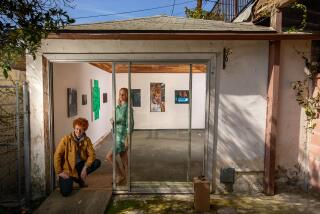Creative Ideas Marking Day Without Art : Art: The AIDS-awareness observance on Friday will feature exhibitions, readings and other events as well as the usual shrouding of some pieces.
- Share via
Day Without Art--the annual AIDS-awareness day observed every Dec. 1 by arts institutions--has become something of a misnomer. As announcements of this year’s events stack up, it appears that the 1995 version could just as aptly be called Day With Art About AIDS.
As usual, local museum visitors on Friday will be deprived of seeing a few artworks that have been shrouded to pay homage to artists who have died of complications of AIDS and to call attention to the disproportionate toll the disease has taken on the arts community. Maren Hassinger’s “Evening Shadows” sculpture at Cal State Long Beach’s University Art Museum and Jonathan Borofsky’s “Ruby,” a figurative piece on the roof of the Newport Harbor Art Museum, will be under wraps. The J. Paul Getty Museum in Malibu will drape all 13 Greek and Roman sculptures in its atrium gallery, and UCLA will cover works in the Franklin D. Murphy Sculpture Garden.
But several other institutions are taking a distinctly different tack by presenting AIDS-related programs, sometimes in addition to traditional observances. Perhaps the most ambitious event is “TranscEND AIDS,” an exhibition of works by 12 artists with AIDS, at the Los Angeles Center for Photographic Studies in Hollywood. It’s the debut show of the Estate Project for Artists With AIDS, an organization established in New York four years ago to help artists who have contracted the disease to continue their work and preserve their artistic legacy.
In New York, the Estate Project has devoted itself to providing services and public education, director Patrick Moore said. “But here in Los Angeles, we thought the fastest way to make ourselves known would be to show art, so that people can see what they would be missing without these artists’ work.” The exhibition is supported by the City of Los Angeles’ Cultural Affairs Department and AIDS Coordinator Ferd Eggan, who has written an essay for the illustrated catalogue.
“Judging art isn’t what the Estate Project is about,” Moore said. “But we thought that if we were going to do an exhibition, the artists should be well represented.” A selection committee was charged with being “as inclusive as possible” in their choice of artists while curating a coherent, high-quality show, he said.
In addition, the Estate Project will present a benefit performance of film director John Waters’ “A Matter of Taste” at Friday night’s opening of the Gramercy International Art Fair at the Chateau Marmont Hotel in Hollywood. “We thought the performance would appeal to Los Angeles’ entertainment, artistic and gay communities,” Moore said. “It’s also a good way to thank the artists.”
Also opting for programs about AIDS, among other Day Without Art activities, the Los Angeles County Museum of Art and the Museum of Contemporary Art will present readings by members of the AIDS Project Los Angeles Writers Workshop. UCLA at the Armand Hammer Museum of Art and Cultural Center will screen “DiAna’s Hair Ego: AIDS Info Up Front,” a video on a community-based approach to AIDS education. The City of Santa Monica is exhibiting artist-designed posters about AIDS at St. Augustine’s By-the-Sea, in conjunction with an interfaith service and candle-lighting ceremony.
*
These changes are not simply a Southern California phenomenon, according to Nick Debs, director of Visual AIDS, a New York-based volunteer group of arts professionals that organizes Day Without Art. As the day of mourning and activism has grown from an event supported by a few dozen New York galleries and museums to a worldwide commemoration with 6,500 participants, the focus has broadened.
Day Without Art began seven years ago as “a negative affirmative action,” Debs said. “It was a symbolic strike. That has changed. There are difficulties with a strike-like event. Americans don’t like strikes.” Furthermore, he said, some longtime participants got bored with doing the same thing each year, while others thought draping artworks was “a little bit lugubrious. That was the point, but people don’t like to get bummed out.”
Many institutions all around the world still observe Day Without Art by shrouding statues, Debs said, and Visual AIDS encourages that activity as an easy and effective way to send a message. But the organization also endorses lectures, readings, performances, exhibitions and other programs, as long as they are “in good taste” and “don’t turn out to be street fairs” or exploitative fund-raising ventures, he said.
Indeed, Day Without Art programs got an official push from Visual AIDS last year. This time around, the organization will use the day to spread the word about its new Archive Project, which documents the work of artists with AIDS in photography, video and text. “We consider it a model for action,” Debs said.
More to Read
The biggest entertainment stories
Get our big stories about Hollywood, film, television, music, arts, culture and more right in your inbox as soon as they publish.
You may occasionally receive promotional content from the Los Angeles Times.










